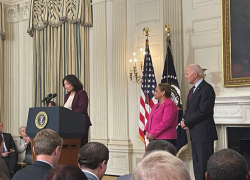Every year in America, 1 in 5 adults experiences some form of mental illness, 1 in 20 experiences a serious mental illness and 17 million experience a substance use disorder and mental illness. Despite the prevalence of mental health conditions, there’s still a stigma around discussing mental health and its treatment, especially at work – but there shouldn’t be.
Mental health is health – period. The more openly we can discuss it, without judgment, the faster we can help our co-workers and friends get the support and treatment they need. The personal benefits of early intervention are obvious, and there’s an economic case for quick treatment, too. The National Alliance on Mental Illness estimates that serious mental illness causes workers who don’t receive adequate treatment $193.2 billion in lost earnings each year – but there’s good news. Because 80% of employees who receive treatment for mental illness report improved efficacy and satisfaction at work.
The workplace can be a source of mental health support for workers of all ages, in all types of jobs and from all backgrounds. A better understanding of the prevalence of mental health conditions is prompting many employers to consider new strategies to support their employees’ mental health.
Since May is National Mental Health Awareness Month, we’re taking advantage of the opportunity to highlight some of the things the Department of Labor is doing to promote mental health at work.
Reducing the Stigma
We’re reminding workers and employers that we all have a role to play in supporting mental health – and encouraging others to spread the word by sharing our -public service announcements on mental health.
We’re hosting a Twitter chat May 11 at 1 p.m. ET to highlight tips, resources and best practices to support mental health at work. We’ll be tweeting from @USDOL, and you can join the conversation using #MentalHealthAtWork.
Secretary of Labor Marty Walsh is speaking out about his own experience with substance use care, and reiterating his commitment to ensuring that everyone gets the mental health and substance use care they’re entitled to.
Educating Workers
We’re making sure workers are aware of their rights and the resources available to them, including:
- How to use the Family and Medical Leave Act for mental health services.
- How to use employer-sponsored health plans to cover mental health and substance use services.
- Recognizing the risk factors for opioid misuse, addiction and overdose.
- Answers to common questions about the Mental Health Parity and Addiction Equity Act.
Educating Employers
We’re making sure employers are aware of their responsibilities and the resources available to them, including:
- Workplace mental health, inclusive telework, neurodiversity in the workplace and more.
- How to support and accommodate workers with mental health conditions.
- How to foster a mental health-friendly work culture.
- Accommodating employees with mental health conditions.
- How to develop mental health safety programs, particularly in industries with high suicide rates.
- A self-compliance tool for employers to determine if they’re following the Mental Health Parity and Addiction Equity Act.
For employers who want to launch a workplace mental health initiative, we’ve got case studies of how other employers have created mental-health-friendly workplaces.
Increasing Parity for Mental Health Treatment
We’re ramping up efforts to enforce parity in mental health services.
We’re making sure employees have resources to determine if their employer-provided health insurance covers mental health or substance use services and providing guidance on how to take advantage of mental health and substance use disorder benefits.
What Can You Do?
We can all help promote a mental-health-friendly workplace. You’ve seen what we’re up to. So, what can you do? You’ve got plenty of options, but here are a few things you can do to create a more inclusive, mental-health-friendly work environment:
- CEOs can set the tone for a supportive culture.
- Managers and supervisors can offer assistance and accommodations.
- Co-workers can listen and offer support.
- People with mental health conditions can ask for what they need to succeed at work, even if they choose not to disclose their condition.
- Share our mental health PSA on social media.
- Start a conversation at work using our “Mental Health at Work: What Can I Do? - A Workplace Guide.”
- Print and post some of our “Mental Health at Work: What Can I Do?” Posters, or order them for free by mail. Available in English and Spanish.
You can also join our Twitter chat on May 11 and share tips and resources to support #MentalHealthAtWork.
Julie Su is the deputy secretary of labor.

 U.S. Department of Labor Blog
U.S. Department of Labor Blog




